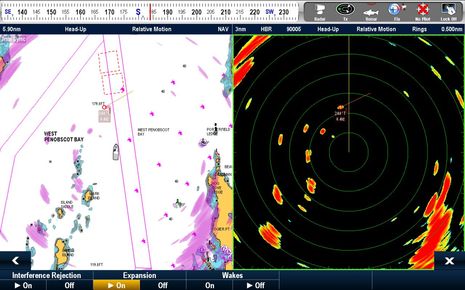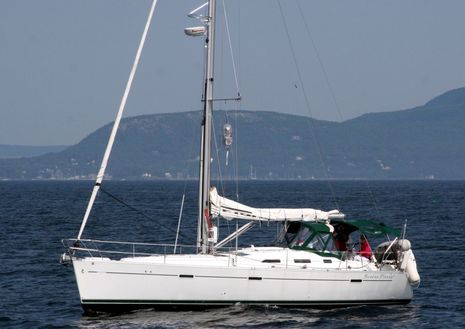The Passive Radar Reflector Solution for Sailboats

July 2006, Block Island Sound is enveloped in patchy fog, two radar-equipped sailboats pass within 20 feet after failing to detect each other despite calm waters. Neither vessel had a radar reflector hoisted. July 2009, chaos on Block Island Sound as fog descends on hundreds of recreational boaters, skippers constantly calling out on VHF 9 & 16 in attempts to avoid collision. A ferry and a coast guard ship actually do collide. In the melee, just 1 of every 35 boats is sporting a radar reflector. July 2010, dozens of boats make their way through hours of heavy rain and thunderstorms into Nantucket Island, and only 2 have radar reflectors. May 30, 2011, 30 sailboats travel in heavy fog across Long Island Sound from Huntington to Saugatuck, the heavy fog was forecast...the number of boats sporting radar reflectors...just one.
Geez, when did safety slip to the bottom of sailor's priority list? Are radar reflectors so difficult to use? Too confusing maybe? Or is there an overall lack of faith they are worth the effort to hoist?
It seems like nearly all sailors in the Northeast fail to use their radar reflectors. On foggy days in the northeast USA I have observed, at most, 1 in 35 sailboats sporting a radar reflector, and among them most had severe limitations being fixed mount, too small, not kept level, and more than half a combination of all three limitations. Comparatively, 90% of over 50 sailors I informally surveyed, claim to own a radar reflector, in a locker, somewhere. 100% of them described a Davis or Davis-like design. 0% have used them.
Well, no more excuses! The Echomax 230 I Inflatable passive radar reflector is an easy to deploy reflector with no sharp edges, no confusing instructions, and although big, is so soft and cuddly you can leave it up in your rigging days on end without worries and be assured, when bad weather appears, the radar cross section of your sailboat becomes significantly increased making it easier to be seen by others around you.
This product was designed for use on a life raft after storage in a ditch bag, but I have found that it overcomes the barriers to continuous use of reflectors on sailboats, as proven on my sailboat after five seasons and 3400 nm of sailing in the Northeast.
There are numerous articles written about passive radar reflectors defining how performance should be measured, limitations of various designs, and some exposing that various products are entirely or partially ineffective. Not too much new has been written recently. The articles going back to 1991 could be summed up as follows:
- Radar reflectors don't provide a uniform reflection around their perimeter; there are high and low points around a 360 degree arc, for instance.
- Radar reflector performance is measured as radar cross-section (RCS) in square meters. An RCS of 10 is considered to be an acceptable value for reflection performance, the point at which another ship's radar will reliably paint a protected boat on an operator's display.
- There is no substitute for having a big radar reflector as no fancy design (yet discovered) can enable a small radar reflector to be as effective as a larger one. The result is that reflectors that are large enough to deliver an RCS of 10 across much of a 360 degree arc around your boat, need to be of sizes like 16 inches round or larger.
- Even at these sizes, the majority of products on the market don't achieve a minimum acceptable level of RCS > 10 in all directions around the boat without some degree of care by the owner to maintain correct orientation.
- Various fancy designs are better overall across a 360 degree arc than others. Such designs known as "octahedral-type reflectors" mounted in the "double catch rain position" are measured to be the most uniform around a 360 degree arc and therefore, make your boat more likely to be seen.
- The David Echomaster is an example of such a design, but it becomes ineffective if tilted even a few degrees from the double catch rain position, as the reflected radar energy is greatly reduced. (Page 28, Report on the investigation and loss of the sailing yacht Ouzo, Marine accident investigation branch, United Kingdom, April 2007).
It was in fact the David Echomaster I decided on in 2006 for my new 39 foot sailboat. It had the prerequisite of being large, had the best overall performance, and I convinced myself I could keep it in the double catch rain position so it would be effective. I kept it stored in a locker folded up in the protective plastic pouch it comes in, ready to be deployed.
And there it sat and I never used it. Each time I should have, it remained in the locker. Either I had too many other things to attend to during bad weather, it was unsafe for me to be on deck or I was in the state of mind that I could use my own radar to keep distance between me and the other boats nearby. Three near collisions later, I was nervous. I purchased an active radar reflector at a West Marine closeout, but then returned it due to the difficulty in installation, its weight and the serious limitations it had interacting with more than one radar at close range.
That winter I began to seriously look at my original second choice, an EchoMax 230. I originally didn't like that the product was huge and that the best position to mount it was forward of my mast where it would disrupt the wind from attaching to the mainsail. Also the weight of the reflector and mounts aloft were undesirable. But, it had no sharp edges and could be left up all the time, insuring that it would be used when needed.
As I was checking the vendor's site for a purchase, I came across the EchoMax 230 I inflatable. It was designed for inclusion in a ditch bag, to be inflated in an emergency on board a life raft. It sounded ideal for hoisting on a flag halyard as I had originally planned for the Davis product, but absent sharp edges meant I could leave it in the rigging unattended whenever I was underway, good weather or bad. This would have many advantages:
- I could hoist it at the start of every cruising trip, and with a line run from the bottom of the reflector to the deck, change it's angle to match the heel of my boat to keep level with the horizon.
- Unlike a fixed mast mount, it would not disturb air on the leading edge of my mainsail (reducing sailing performance).
- Good weather or poor, sailing or motoring, my sailboat would be visible to other ships radar.
I emailed the manufacturer telling them this was how I would use it, and if they thought it was durable enough that I could get at least a year out of it. I was told my application was unique, but they would warranty it for a year if I would underinflate it so there is room to expand on hot days.
What a difference, although its big (size is of tantamount importance) I actually used it all season and was comfortable leaving it up full time. This inflatable:
- was used 100% of the time in bad weather from 2007 through its fifth season on board this year. This is due in large part to the little effort required to set it up as part of my routine before setting sail, effectively insuring it's just there when conditions of night or fog come to pass. Also, with the soft sides it feels non-threatening to set it up.
- although made out of plastic, it appears no worse for the wear in its fifth seasons, even though it has been up there in some pretty violent winds, thunderstorms, and was accidentally left up in October 2007 during a brutal nor-easter (having forgotten to take it down).
- being an "octahedral-type reflector" mounted in the "double catch rain position", provides the best of the various designs available for passive radar reflector. (e.g. 360 degree coverage arc)
- is fairly easy to keep in the required vertical position when sailing by moving a lead from the bottom of the reflector to various positions in the rigging, and it stays in that vertical position during pretty strong winds.
- positioned off the flag halyard, it doesn't interfere with the wind going across my sails as it would have in a fixed mount, and has never become tangled with my rigging.
- When I queried various vessels underway, including ferries, tow boats, tug boats, and recreational powerboats, they all replied that my sailboat was visible on their radar. I received that same positive response from ferries during heavy rain off Nantucket in 2009, in conditions when radar performance is very poor with limited ranges of only a couple miles.
- In rendezvous with Gizmo last week, Ben was able to compare my sailboat with and without the reflector raised, using a Raymarine HD radar. He was able to confirm the reflector is effective in making Breeze Pleeze more noticable on radar, even with five years of use (the reflector was designed to be stored until needed). In our rendezvous I was next to a large buoy, then out among other sailboats one mile, two, then many miles from Gizmo. In our tests the reflector was partially deflated (to allow room to expand when warm), was 15 feet above the deck hanging from a flag halyard (see picture), and was tilted about 5-10 degrees due to the angle of the wind across the deck. (maximum reflection is achieved when it is level)
The only faults I can find with EchoMax 230 I is a need for lateral reinforcement for continuous use (which is easily added with a bit of line between top and bottom as illustrated in this PDF), better labeling (how about writing "reflector" in big letters) so other mariners understand what it is, and the warranty is far too short considering it looks like new after five years and a dozen storms. In the area of faults, the marketing is awful, the manufacturer grossly missed the mark when targeting this product for emergency grab bags for life rafts.
Without a doubt, this product is a superb solution for the common sailboat and belongs up in the rigging of most every sailboat from the moment it is underway if there is any chance of poor weather.
- Dan Corcoran is an avid sailor and leads ServiceSPAN, a back office work center automation technology company. {That's his sloop Breeze Pleeze as a solid MARPA target on Gizmo's radar.}



 Share
Share
I have the The Firdell Blipper model on our sailboat, although this model tesing turns our to be disappointing we do not sail in an area that has much fog...Miami, FL...
Here is a link to an old but very detailed test done on many radar reflectors...
http://offshore.ussailing.org/Assets/Offshore/SAS+Studies/radar+reflector+tests.pdf